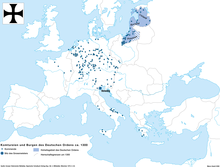Coming Welheim
| Coming Welheim | ||
|---|---|---|
|
Location map |
||
| Creation time : | before 1255 | |
| Geographical location | 51 ° 31 '19.3 " N , 6 ° 58' 35.5" E | |
|
|
||
The Kommende Welheim was a medieval knight's seat in the form of a moated castle in Bottrop and a settlement called Kommende of the Westphalian Ballei of the Teutonic Order in Vest Recklinghausen in the Electorate of Cologne .
history
The Welheim estate originally belonged to a family of the same name. In 1230 Everhard von Welheim gave his estate to the Teutonic Order, which expanded it to the coming. Until the secularization , the Chapel of the Coming remained the main Catholic church of Welheim , Batenbrock and Boy .

The complex originally consisted of an outer bailey with a farmyard, palace chapel, gardens and the actual moated castle, the Komturhaus . The entire complex was destroyed several times - for example in the Eighty Years' War in 1598 - and last rebuilt in 1723.
From the foundation of the Kommende in 1254 until the Reformation in 1572, it had the right of patronage over the Salvatorkirche in Duisburg, and the respective commander was hereditary mark judge in the Welheimer Mark. Considerable real estate was acquired through donations and purchases, and the newcomer became the largest landowner in the area. She also had the right to use the wilderness in the Emscherbruch for breeding Emscherbruch horses, first documented for the year 1369.
Economically, the coming was not always profitable for the Teutonic Order. Bankruptcy at the end of the 17th century was only prevented by the commander's income waiver. In the course of secularization, the estate came into the possession of the Duke of Arenberg . The last commander received a lifelong pension. The lands were gradually lost. In 1928 the Prosper coking plant was built right next to the castle . The building was hit by bombs during the Second World War, its remains were dismantled in 1954 and the land was leveled in 1980 and some workshops were built on.
Monuments
A memorial stone is now on Prosperstrasse. On May 4, 2005, the area with moats and remains of the cellar vault was entered under No. B 6 in the list of ground monuments of the city of Bottrop.
Commander
- Gerhardus dictus Kukenmestre (1254–1257)
- Hinrich van Laykem (1344)
- Heinrich von Dungeln (Henriche van Dunghelen) (1377)
- Sweder of Vondern (1396)
- Sweder of Vörde (1403)
- Francke van Hompel (1470)
- Hinrick van Bodelschwingh (Boelswynge) (1491)
- Wilhelm Overlacker (1529-1535)
- Hermann Overlacker (1540–1560)
- Röttger Overlacker (1565–1577)
- Christoph von Dellwig (1591–1625)
- Rab Luther von Schilder (1629–1632)
- Henrich von Ittersum (1628–1650)
- Eberhard von Dellwig (1651/52)
- Henrich von Ittersum (1653 / 53–1660)
- Gisbert von der Capellen (1662–1670)
- Eberhard von Dellwig (1671–1674)
- Johann Hunold von Plettenberg (1675–1679)
- Wilhelm von Plettenberg (1679–1688 / 92)
- Ferdinand Röttger von Dobbe (1692–1703)
- Georg Levin von Nagel (1705–1711)
- Rosier Gottfried von Dellwig (1713-1718)
- Franz Gaudenz Xerxes of Westrem (1718–1724)
- Franz Wilhelm Bernd von Westrem (1727–1729)
- Raban Henrich von Haxthausen (1737–1793)
- Friedrich Ernst von Spiegel (1793–1794)
- Johann Wilhelm von Loe
Welheimer trip
Since the 14th century, the Essen St. Sebastian riflemen moved to the Welheimer Kommende on the Wednesday after Whitsun. This thanked with the repeated invitation for the protective function of the Essen riflemen for the coming. This tradition was ended on June 3, 1789 by the Vestic governor Count von Nesselrode. He had 600 Recklinghauser riflemen take up positions at the Emscher crossings to prevent the Essen riflemen from crossing. The riflemen withdrew and a guerrilla war was prevented. A painting by Josse Goosen on the Welheim trip hangs in the council chamber of the Bottrop town hall . Today this tradition is re-cultivated by the Bottrop Historical Society .
literature
- Werner Bergmann, Otto Dickau, Heinz-Jürgen Kamp: History and sources of the German Order Coming in the Ruhr area using the example of the Coming Welheim. From the beginning to the eve of the Reformation . Henselowsky Boschmann, Bottrop 2017, ISBN 978-3-942094-74-0
- Hans Jürgen Dorn: The Deutschordensballei Westphalia (= sources and studies on the history of the Teutonic Order , vol. 26). Elwert, Marburg 1978, ISBN 3-7708-0617-4 , pp. 35-45.
- Johann Heinrich Hennes: Codex diplomaticus Ordinis Sanctae Mariae Theutonicorum. Document book of the Teutonic Order . Vol. 2: In particular the Balleien Coblenz, Altenbiesen, Westphalen and Lorraine . Kirchheim, Mainz 1861 ( digitized version of the Bavarian State Library).
- Johannes Körner (edit.): The architectural and art monuments of Westphalia , vol. 39: District of Recklinghausen and urban districts of Recklinghausen, Bottrop, Buer, Gladbeck and Osterfeld . Aschendorff, Münster 1929.
- Rudolf Schetter : Good and Coming Welheim and the Bottrop Chapel . In: Vestische Zeitschrift , Vol. 68/69 (1966), pp. 106-134.
Individual evidence
- ↑ Annette Krus-Bonazza: "At Cranger Kirmes". From the horse market to the Oktoberfest des Westens (= contributions to folk culture in north-west Germany. H. 80). Coppenrath, Münster 1992, ISBN 3-88547-186-1 . ( Full text as PDF )

